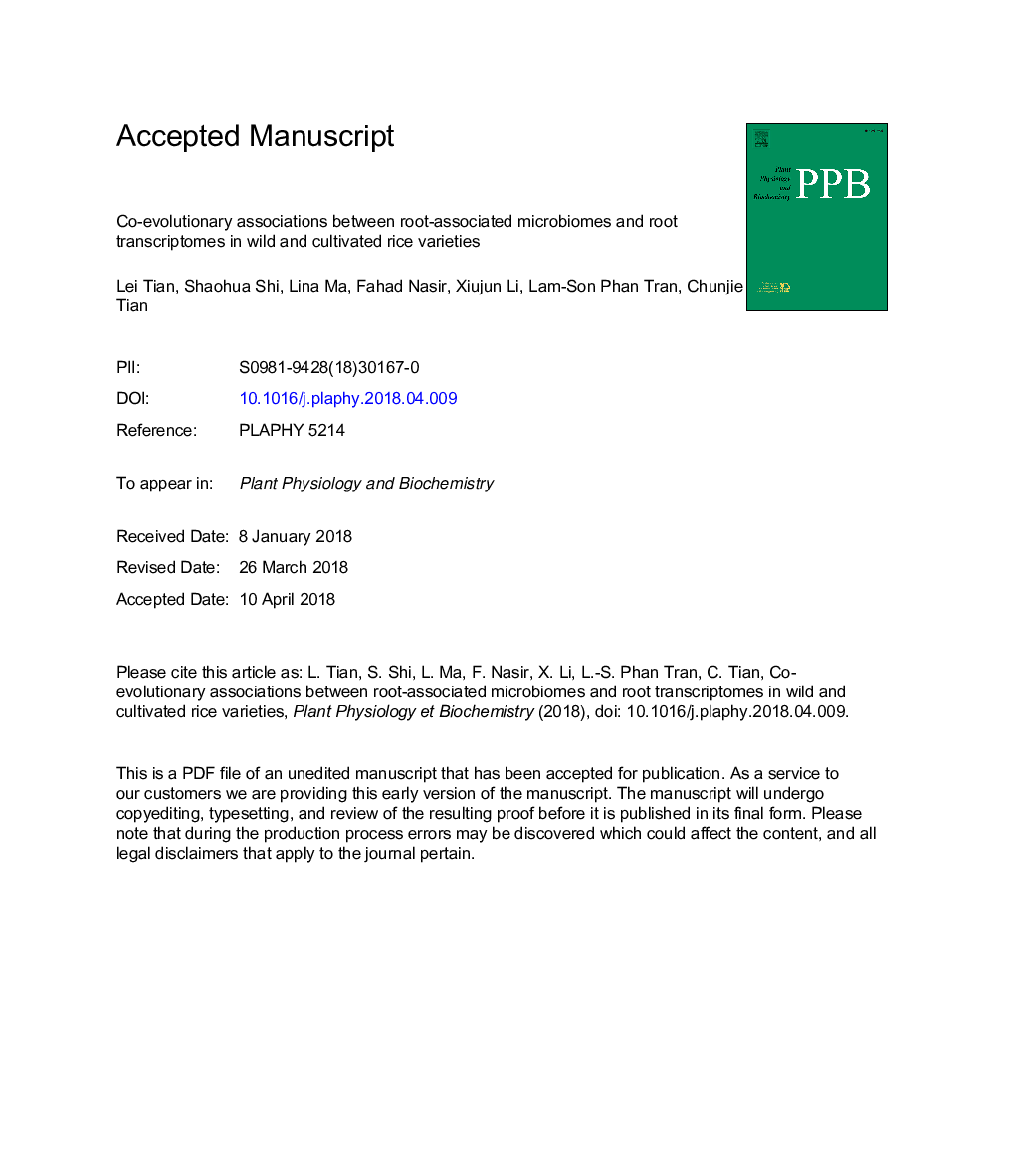| کد مقاله | کد نشریه | سال انتشار | مقاله انگلیسی | نسخه تمام متن |
|---|---|---|---|---|
| 8352913 | 1541893 | 2018 | 32 صفحه PDF | دانلود رایگان |
عنوان انگلیسی مقاله ISI
Co-evolutionary associations between root-associated microbiomes and root transcriptomes in wild and cultivated rice varieties
ترجمه فارسی عنوان
ارتباطات تکاملی بین میکروبیوم وابسته به ریشه و ترانسکتومات ریشه در گونه های برنج وحشی و کشت شده
دانلود مقاله + سفارش ترجمه
دانلود مقاله ISI انگلیسی
رایگان برای ایرانیان
کلمات کلیدی
Cultivated riceITSIAARDADEGsACC1-aminocyclopropane-1-carboxylic acid - 1-آمینوسیلیکوپروپان-1-کربوکسیلیک اسیدOTU - OTInternal transcribed spacer - Spacer رونویسی داخلیindoleacetic acid - اسید IndoleaceticWild rice - برنج وحشیredundancy analysis - تجزیه و تحلیل اضافیPathway analysis - تجزیه و تحلیل مسیرTranscriptome - ترانسکریپتومVersus - در مقابلMicrobiome - میکروبیومoperational taxonomic unit - واحد تاکسونومی عملیاتیDifferentially expressed genes - ژن های متفاوت بیان شده است
موضوعات مرتبط
علوم زیستی و بیوفناوری
علوم کشاورزی و بیولوژیک
دانش گیاه شناسی
چکیده انگلیسی
The plants and root-associated microbiomes are closely related. Plant metabolic substances can serve as a nutrient source for the microbiome, and in return, the microbiome can regulate the production of plant metabolic substances. Wild rice (Oryza rufipogon), as the ancestor of cultivated rice (Oryza sativa), has changed several metabolic pathways and root-associated microbiome during evolution. Thus, the study of the different associations between metabolic pathways and root-associated microbiomes in wild and cultivated rice varieties is important for rice breeding. In this article, the co-evolutionary association between metabolic pathways, which are based on transcriptome data, and root-associated microbiomes, which are based on 16S rRNA and internal transcribed spacer (ITS) amplicon data, in wild and cultivated rice was studied. The results showed that the enriched pathways were differentially correlated with the enriched microbiomes in wild and cultivated rice varieties. Pathways for 'Glutathione metabolism', 'Plant-pathogen interaction', 'Protein processing in endoplasmic reticulum' and 'Tyrosine metabolism' were positively associated with the improved relative abundance of bacterial and fungal operational taxonomic units (OTUs) in wild rice. On the other hand, 'Glycolysis/Gluconeogenesis', 'Brassinosteroid biosynthesis', 'Carbon metabolism', 'Phenylpropanoid biosynthesis' and 'Caffeine metabolism' were positively correlated with the improved relative abundance of bacterial and fungal OTUs in cultivated rice. Redundancy analysis showed that certain bacterial and fungal species could positively and significantly affect plant gene expression; for instance, Streptomyces, with 8.7% relative abundance in bacterial community, significantly affected plant gene expression in wild rice. This study can provide the theoretical basis for recognizing the associations between root-associated microbiomes and root transcriptomes in wild and cultivated rice varieties, and can provide practical significance for developing useful bacterial and fungal resources in wild rice.
ناشر
Database: Elsevier - ScienceDirect (ساینس دایرکت)
Journal: Plant Physiology and Biochemistry - Volume 128, July 2018, Pages 134-141
Journal: Plant Physiology and Biochemistry - Volume 128, July 2018, Pages 134-141
نویسندگان
Lei Tian, Shaohua Shi, Lina Ma, Fahad Nasir, Xiujun Li, Lam-Son Phan Tran, Chunjie Tian,
